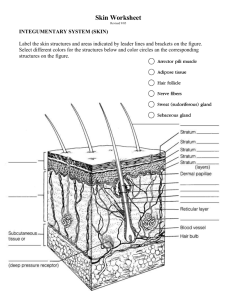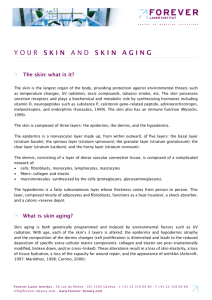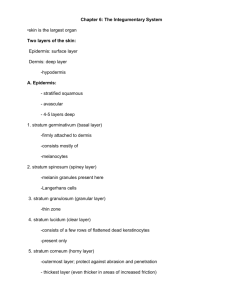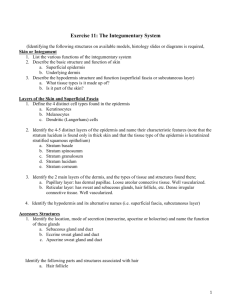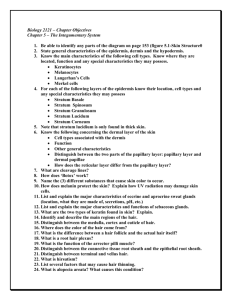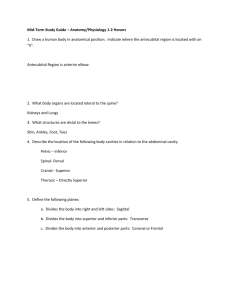Test - Scioly.org
advertisement
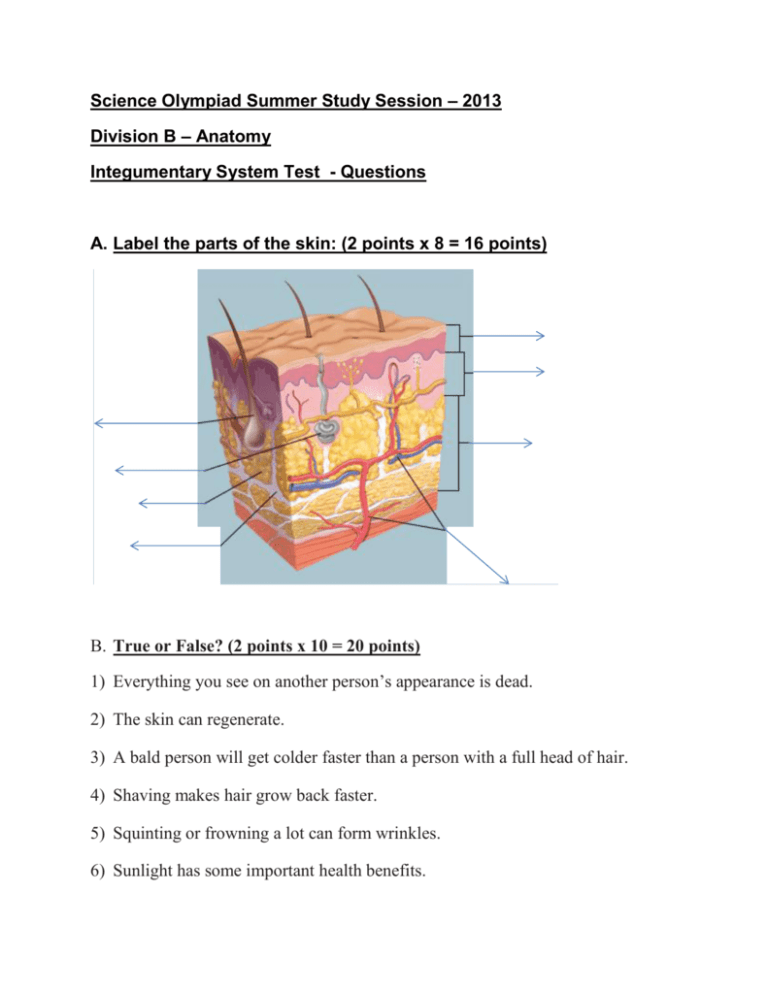
Science Olympiad Summer Study Session – 2013 Division B – Anatomy Integumentary System Test - Questions A. Label the parts of the skin: (2 points x 8 = 16 points) B. True or False? (2 points x 10 = 20 points) 1) Everything you see on another person’s appearance is dead. 2) The skin can regenerate. 3) A bald person will get colder faster than a person with a full head of hair. 4) Shaving makes hair grow back faster. 5) Squinting or frowning a lot can form wrinkles. 6) Sunlight has some important health benefits. 7) Tanning from a tanning bed is less dangerous than sun tanning. 8) Females have a thicker hypodermis than males. 9) The hypodermis is considered a separate layer of the skin. 10) Nails grow faster in warm climates and during daytime, than in cold climates and at night. C. Multiple Choice Questions: (2 points x 10 = 20 points) 1) What disease are people with albinism prone to? a) Acne b) Skin Cancer c) Rashes d) Keratosis 2) Recently, reports in the United States and Europe have shown vitamin D deficiencies and rickets-like symptoms in children. Why? a) Poor nutrition b) Childhood vaccination c) Too much time indoors and usage of strong sunscreens d) Lack of exercise 3) Which of the following is not a cell found in the epidermis? a) Epithelial cells b) Melanocytes c) Keratinocytes d) Fibroblasts 4) Which is NOT a function of hair in humans? a) Sensation b) Major mechanism to maintain body warmth c) Protection from the sun’s UV radiation d) Helps keep harmful particles out of the body 5) Which of the following is not a cause of hair loss? a) Hormonal changes b) Sensitivity to DHT c) Melanin changes d) Dietary changes 6) Which of the following connects the epidermis to the dermis? a) Stratum Granulosum b) Stratum Spinosum c) Stratum Corneum d) Stratum Basale 7) Which direction is the epidermis from the rest of the body? a) Dorsal b) Deep c) Superficial d) Ventral 8) Which of the following terms is properly matched to its function? a) Epidermis – Functional b) Dermis – Protection c) Hypodermis – Connection d) None of the above 9) Which of the following connective tissue fiber types is not usually found within the dermis? a. b. c. d. Reticular Elastic Fibrous Collagenous 10) a) b) c) d) Cell division in skin take place in Stratum Granulosum Stratum Spinosum Stratum Corneum Stratum Basale D. Fill in the blanks: (2 points x 12 = 24 points) 1. The dermis is composed mainly of ____________________. 2. The secretion which lubricates and inhibits the growth of bacteria on the skin is called ___________________. 3. Hair develops from a group of epidermal cells at the base of a tube-like depression called a(n)_____________. 4. Mammary glands are modified______________. 5. The stratum germinativum contains both stem cells and ________________. 6. An abnormal growth in epidermal cells is most likely__________________. 7. The characteristic protein of hair and nails is the fibrous, insoluble protein called_______________. 8. The terms “thick skin” and “thin skin” are used in reference to the relative thickness of the _______________ and not to the skin as a whole. 9. The thick skin of the palms and the soles has epidermal______________ that increase friction and improve gripping ability. 10. Both the ______________ nervous system and hormones control secretion by glands and contraction of myoepithelial cells. 11.Sebum is produced in ____________ glands. 12. Sweat is produced in ____________ glands. E. Match the following: (1point x 10 = 10 points) 1. Keratinocytes Stratum Lucidum 2. Merkel cells Fatal and complicated cancer 3. Langerhans cells Common cancer but easy to cure 4. Basal cell carcinoma Stem cells 5. Melanoma Helps immunity 6. Stratum Basale Skin treatment 7. Melanin Protection and Water-proof 8. Palm Cell Division 9. Botox Sensory Receptor 10. Basal cells Gives Skin color F. Diagnose the skin diseases: (5 points x 2 = 10 points) Following are the images of body parts affected by common skin diseases. Name the diseases; identify the possible causes and remedies. Picture 1: Picture 2:
